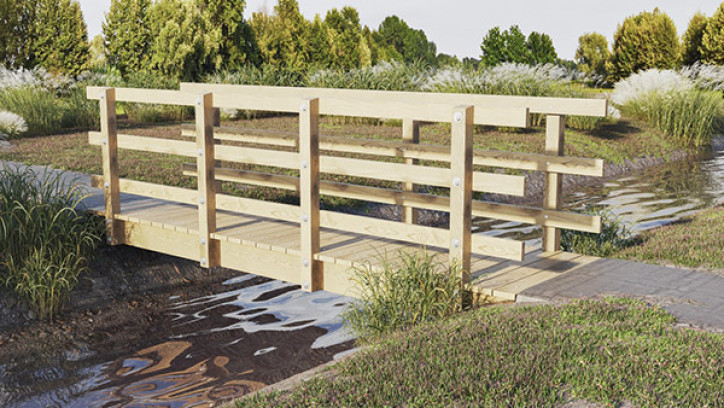7.2 Short-span bridges on private land

Short-span bridges could have various applications. They are commonly single span in structure and single lane in width, with abutments (supports) anchored to the banks of a stream or river.
Please note: The below exemption comes into force from 31 August 2020. You will still need a building consent if your project starts before this date.
Short-span bridges (span means the actual total length of deck less than 6 metres) could have various applications. They are commonly single span in structure and single lane in width, with abutments (supports) anchored to the banks of a stream or river. Short-span bridges are constructed above a stream or river's normal flow-level.
The falling height in this exemption is a vertical distance from the ground which should be measured from the lowest point of the river-bed, stream or creek to the top level of the bridge deck. Furthermore, the span is the actual distance between the vertical supports (abutments) of a bridge which are anchored into the river bank. If the short-span bridge has multiple piers or spans, the total length of deck must be less than 6 metres.
The intended usage of a bridge can cover various cases such as medium-sized vehicles and farm trucks. In farms and private properties, short-span bridges are sometimes designed to pass over a stream or river. If it is likely that the bridge will be used by members of the public in the future, you should apply for a building consent. Some farmers might use the short-span bridges to facilitate their farm-related operational activities.
Under this exemption, short-span bridges must not be used by a member of public.
Bridge design is commonly done in accordance with the Bridge Design Manual and this manual is a highly recommended technical reference document.
Engineering knowledge is needed to consider the loading conditions, ground conditions and to make the appropriate classification based on the loads and frequency of use the bridge is likely to encounter during its life span (eg light-duty vs heavy-duty). For this exemption to apply, an owner must engage a chartered professional engineer (we recommend a structural and geotechnical engineer) to design the short-span bridge and the building work must be carried out in accordance with that design.
We note that resource consents may be required for short-span bridges location on farms. Most short-span bridges will be anchored to the bank of the stream or river, as they need to comply with council plans (administered by city, district and/or regional councils) under the Resource Management Act (RMA).
If a short-span bridge (owned by a farmer) crosses over the utility networks such as a railway, the farmer should seek advice from their city or district council (territorial authority) and/or consult with the relevant network utility operator (ie Kiwirail) to avoid any potential breach of the RMA or other relevant regulations.
It is recommended that weight or speed limit signs be fixed to the short-span bridges. Whilst installing the appropriate signs generally limits the liability of local authorities for issues resulting from the overloading of short-span bridges on private land, it could also warn other users of short-span bridges such as firefighters or employees.
It should be emphasised that having this exemption for certain size of bridges doesn't prevent the councils from exercising their power to give discretionary exemptions under the Building Act 2004.
Clause 2 of Part 1 of Schedule 1 of the Building Act 2004, which covers discretionary exemptions by councils.
What is exempt
- A farm owner wants to build a short-span bridge over a small creek on their land with a clear span of 5 metres between supports and a fall height of less than 2 metres. The bridge design is undertaken by a chartered professional engineer (structural and geotechnical) and the bridge has capacity signage along with a Building Code complaint barrier. The bridge will only be used by small trucks or small agricultural machinery owned and operated by the farm owner.
- Access to a private urban home is over a short span bridge to cross a small stream. As the bridge has a span that does not exceed 6 metres, does not cross an area with public access, has safety barriers and has a fall height of less than 3 metres, the bridge is exempt.
What needs consent
- A landowner is constructing a small bridge over a river on private land where the bridge is likely to be used by the public or employees of nearby businesses. A building consent is required for this building work as it will be used by members of the public.
- A horse breeder wants to build a small short-span bridge over a river on private land which will not be used by the public. The bridge span which is the actual total length of deck is equal to 7 metres. A building consent is required for this building work as it spans more than 6 metres.
What the law says
47. Short-span bridges on private land
1. Building work in connection with a bridge that—
(a). has a span of less than 6 metres; and
(b). does not span a road, a railway, or any other area with public access; and
(c). is not used by the general public; and
(d). has a safety barrier.
2. However, subclause (1) does not apply to a bridge from which it is possible to fall further than 3 metres even if it collapses.